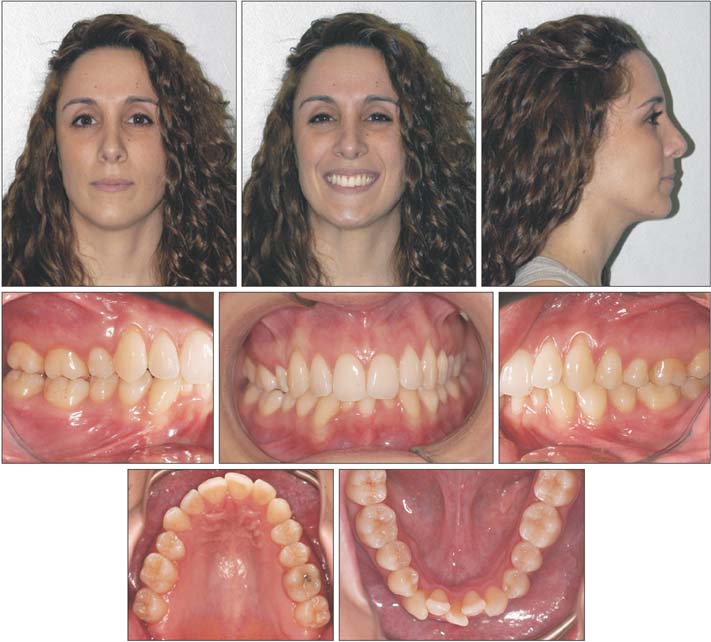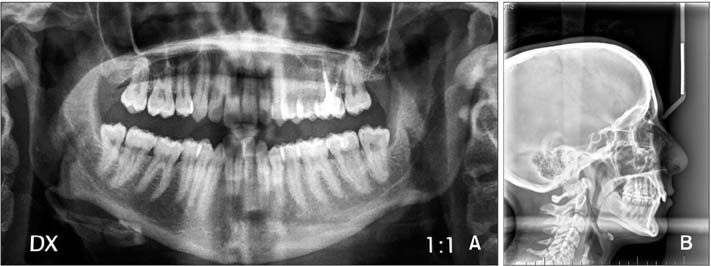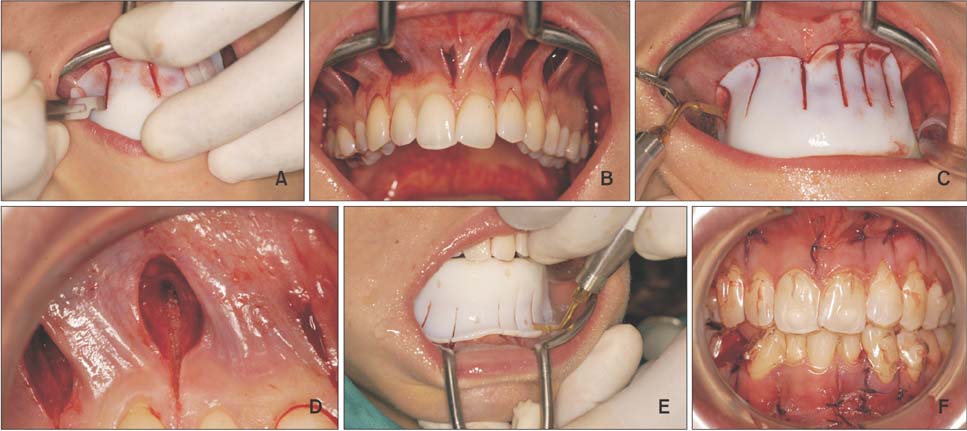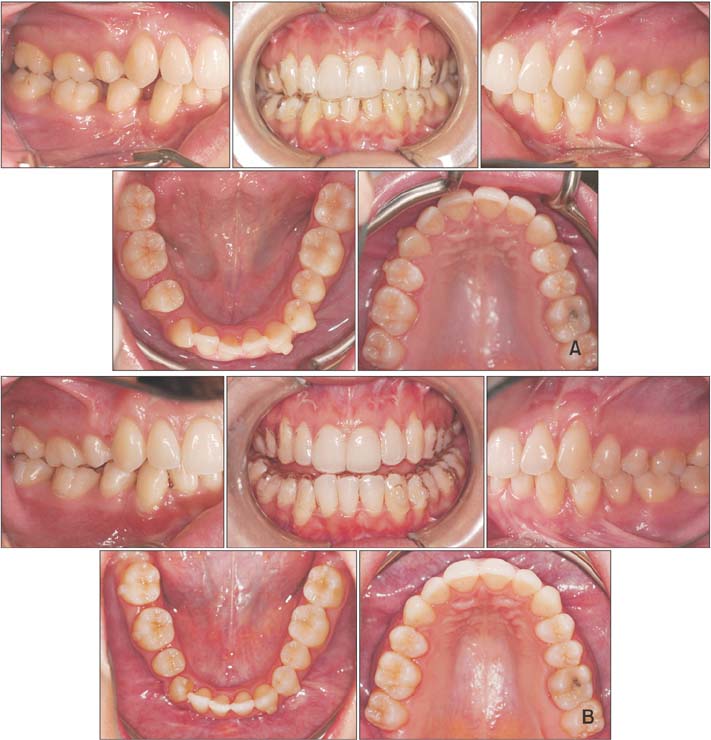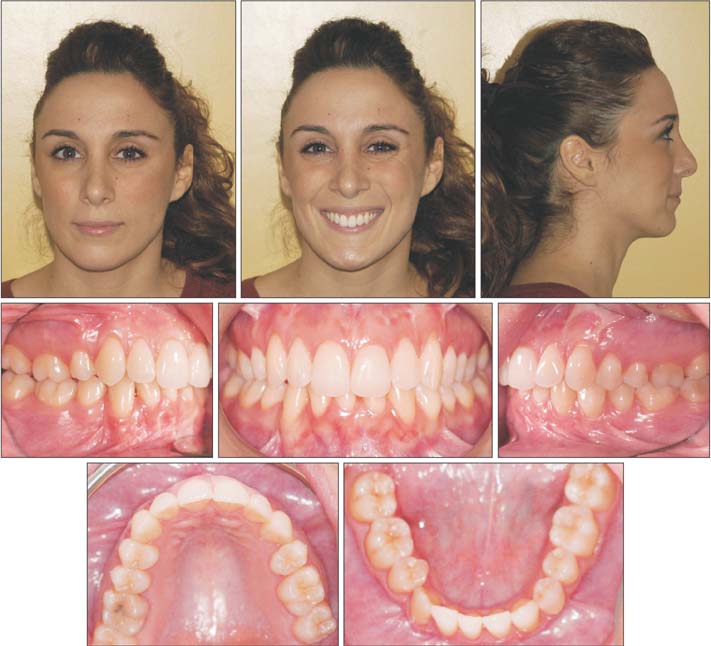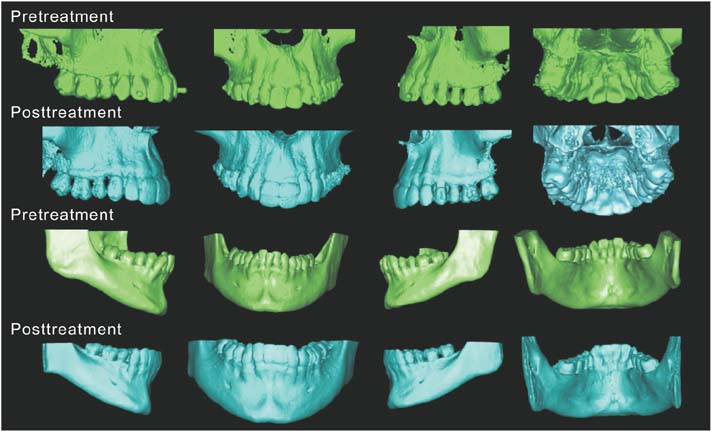Korean J Orthod.
2017 Mar;47(2):130-141. 10.4041/kjod.2017.47.2.130.
The combined use of computer-guided, minimally invasive, flapless corticotomy and clear aligners as a novel approach to moderate crowding: A case report
- Affiliations
-
- 1Department of Oral and Maxillofacial Sciences, School of Dentistry, Sapienza University of Rome, Italy.
- 2Private Practice, Rome, Italy.
- KMID: 2400390
- DOI: http://doi.org/10.4041/kjod.2017.47.2.130
Abstract
- The aim of this case report was to describe an innovative orthodontic treatment method that combined surgical and orthodontic techniques. The novel method was used to achieve a positive result in a case of moderate crowding by employing a computer-guided piezocision procedure followed by the use of clear aligners. A 23-year-old woman had a malocclusion with moderate crowding. Her periodontal indices, oral health-related quality of life (OHRQoL), and treatment time were evaluated. The treatment included interproximal corticotomy cuts extending through the entire thickness of the cortical layer, without a full-thickness flap reflection. This was achieved with a three-dimensionally printed surgical guide using computer-aided design and computer-aided manufacturing. Orthodontic force was applied to the teeth immediately after surgery by using clear appliances for better control of tooth movement. The total treatment time was 8 months. The periodontal indices improved after crowding correction, but the oral health impact profile showed a slight deterioration of OHRQoL during the 3 days following surgery. At the 2-year retention follow-up, the stability of treatment was excellent. The reduction in surgical time and patient discomfort, increased periodontal safety and patient acceptability, and accurate control of orthodontic movement without the risk of losing anchorage may encourage the use of this combined technique in appropriate cases.
Keyword
MeSH Terms
Figure
Cited by 3 articles
-
Corticotomy for orthodontic tooth movement
Won Lee
J Korean Assoc Oral Maxillofac Surg. 2018;44(6):251-258. doi: 10.5125/jkaoms.2018.44.6.251.Effects of thermoforming on the physical and mechanical properties of thermoplastic materials for transparent orthodontic aligners
Jeong-Hyun Ryu, Jae-Sung Kwon, Heng Bo Jiang, Jung-Yul Cha, Kwang-Mahn Kim
Korean J Orthod. 2018;48(5):316-325. doi: 10.4041/kjod.2018.48.5.316.Comparison of tooth movement and biological response in corticotomy and micro-osteoperforation in rabbits
Junghan Kim, Yoon-Ah Kook, Mohamed Bayome, Jae Hyun Park, Won Lee, Hojae Choi, Noha H. Abbas
Korean J Orthod. 2019;49(4):205-213. doi: 10.4041/kjod.2019.49.4.205.
Reference
-
1. Uzuner FD, Darendeliler N. Dentoalveolar surgery techniques combined with orthodontic treatment: a literature review. Eur J Dent. 2013; 7:257–265.
Article2. Cassetta M, Altieri F, Barbato E. The combined use of corticotomy and clear aligners: a case report. Angle Orthod. 2016; 86:862–870.
Article3. Long H, Pyakurel U, Wang Y, Liao L, Zhou Y, Lai W. Interventions for accelerating orthodontic tooth movement: a systematic review. Angle Orthod. 2013; 83:164–171.4. Wilcko W, Wilcko MT. Accelerating tooth movement: the case for corticotomy-induced orthodontics. Am J Orthod Dentofacial Orthop. 2013; 144:4–12.
Article5. Cassetta M, Di Carlo S, Giansanti M, Pompa V, Pompa G, Barbato E. The impact of osteotomy technique for corticotomy-assisted orthodontic treatment (CAOT) on oral health-related quality of life. Eur Rev Med Pharmacol Sci. 2012; 16:1735–1740.6. Cassetta M, Pandolfi S, Giansanti M. Minimally invasive corticotomy in orthodontics: a new technique using a CAD/CAM surgical template. Int J Oral Maxillofac Surg. 2015; 44:830–833.
Article7. Cassetta M, Giansanti M, Di Mambro A, Calasso S, Barbato E. Minimally invasive corticotomy in orthodontics using a three-dimensional printed CAD/CAM surgical guide. Int J Oral Maxillofac Surg. 2016; 45:1059–1064.
Article8. Cassetta M, Ricci L, Iezzi G, Calasso S, Piattelli A, Perrotti V. Use of piezosurgery during maxillary sinus elevation: clinical results of 40 consecutive cases. Int J Periodontics Restorative Dent. 2012; 32:e182–e188.9. Wilcko WM, Wilcko T, Bouquot JE, Ferguson DJ. Rapid orthodontics with alveolar reshaping: two case reports of decrowding. Int J Periodontics Restorative Dent. 2001; 21:9–19.10. Dibart S, Surmenian J, Sebaoun JD, Montesani L. Rapid treatment of Class II malocclusion with piezocision: two case reports. Int J Periodontics Restorative Dent. 2010; 30:487–493.11. Dibart S, Sebaoun JD, Surmenian J. Piezocision: a minimally invasive, periodontally accelerated orthodontic tooth movement procedure. Compend Contin Educ Dent. 2009; 30:342–344. 346348–350.12. Keser EI, Dibart S. Sequential piezocision: a novel approach to accelerated orthodontic treatment. Am J Orthod Dentofacial Orthop. 2013; 144:879–889.
Article13. Milano F, Dibart S, Montesani L, Guerra L. Computer-guided surgery using the piezocision technique. Int J Periodontics Restorative Dent. 2014; 34:523–529.
Article14. Hernández-Alfaro F, Guijarro-Martínez R. Endoscopically assisted tunnel approach for minimally invasive corticotomies: a preliminary report. J Periodontol. 2012; 83:574–580.
Article15. Mathews DP, Kokich VG. Accelerating tooth movement: the case against corticotomy-induced orthodontics. Am J Orthod Dentofacial Orthop. 2013; 144:5–13.
Article16. Frost HM. The biology of fracture healing. An overview for clinicians. Part I. Clin Orthop Relat Res. 1989; (248):283–293.17. Keser EI, Dibart S. Piezocision-assisted Invisalign treatment. Compend Contin Educ Dent. 2011; 32:46–48.18. Djeu G, Shelton C, Maganzini A. Outcome assessment of Invisalign and traditional orthodontic treatment compared with the American Board of Orthodontics objective grading system. Am J Orthod Dentofacial Orthop. 2005; 128:292–298.
Article19. Kravitz ND, Kusnoto B, BeGole E, Obrez A, Agran B. How well does Invisalign work? A prospective clinical study evaluating the efficacy of tooth movement with Invisalign. Am J Orthod Dentofacial Orthop. 2009; 135:27–35.
Article
- Full Text Links
- Actions
-
Cited
- CITED
-
- Close
- Share
- Similar articles
-
- Prosthetic rehabilitation with digital implant planning for a minimally invasive surgery approach
- Radiographic evaluation of marginal bone level alteration around narrow implants placed in narrow alveolar ridge using guided flapless surgery
- Establishment of Minimally Invasive Thoracic Surgery Program
- Orthodontic treatment with clear aligners for a patient with chronic periodontitis
- Laparoscopic Resection of Presacral Tumor: A New Approach in the Era of the Minimally Invasive Surgery

